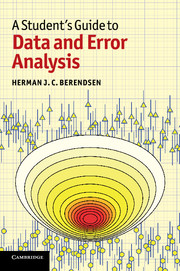Book contents
- Frontmatter
- Contents
- Preface
- Part I Data and error analysis
- 1 Introduction
- 2 The presentation of physical quantities with their inaccuracies
- 3 Errors: classification and propagation
- 4 Probability distributions
- 5 Processing of experimental data
- 6 Graphical handling of data with errors
- 7 Fitting functions to data
- 8 Back to Bayes: knowledge as a probability distribution
- References
- Answers to exercises
- Part II Appendices
- Part III Python codes
- Part IV Scientific data
- Index
8 - Back to Bayes: knowledge as a probability distribution
Published online by Cambridge University Press: 05 June 2012
- Frontmatter
- Contents
- Preface
- Part I Data and error analysis
- 1 Introduction
- 2 The presentation of physical quantities with their inaccuracies
- 3 Errors: classification and propagation
- 4 Probability distributions
- 5 Processing of experimental data
- 6 Graphical handling of data with errors
- 7 Fitting functions to data
- 8 Back to Bayes: knowledge as a probability distribution
- References
- Answers to exercises
- Part II Appendices
- Part III Python codes
- Part IV Scientific data
- Index
Summary
In this chapter the reader is requested to sit back and think. Think about what you are doing and why, and what your conclusions really mean. You have a theory, containing a number of unknown – or insufficiently known – parameters, and you have a set of experimental data. You wish to use the data to validate your theory and to determine or refine the parameters in your theory. Your data contain inaccuracies and whatever you infer from your data contains inaccuracies as well. While the probability distribution of the data, given the theory, is often known or derivable from counting events, the inverse, i.e., the inferred probability distribution of the estimated parameters given the experimental outcome, is of a different, more subjective kind. Scientists who reject any subjective measures must restrict themselves to hypothesis testing. If you want more, turn to Bayes.
Direct and inverse probabilities
Consider the reading of a sensitive digital voltmeter sensing a constant small voltage – say in the microvolt range – during a given time, say 1 millisecond. Repeat the experiment many times. Since the voltmeter itself adds a random noise due to the thermal fluctuations in its input circuit, your observations yi will be samples from a probability distribution f(yi − θ), where θ is the real voltage of the source. You can determine f by collecting many samples.
- Type
- Chapter
- Information
- A Student's Guide to Data and Error Analysis , pp. 111 - 122Publisher: Cambridge University PressPrint publication year: 2011



